I was educated at Blackheath and in Scotland. Up to the War I was in business in the City of London. I was in the Army for upwards of two years, but saw no foreign service. On demobilisation I took up literature, having many years previously determined to do so sooner or later. A Voyage to Arcturus appeared in 1920; The Haunted Woman in 1922; Sphinx in 1923; Adventures of M. de Mailly in 1926. I was married in 1916, and am at present living happily with my wife and two daughters, aged 12 and 9. From 1919 to 1928 we lived in Cornwall; then moved to Ferring in Sussex.
I have done the usual amount of foreign travelling, dislike sports, and take most of my present exercise in tramping the South Downs. My older brother, the late “Alexander Crawford”, also wrote some novels (The Alias, etc.) which by now are almost forgotten. I trace my stock to the main stem of the Lindsays, whose history is in any book of Scottish families. Ivar, Jarl of the Norse Uplanders, is said to have been the original ancestor.
Lindsay’s own biographical summary, written at the time of Devil’s Tor’s publication, quoted in The Strange Genius of David Lindsay, p.6
Childhood & Early Adulthood

David Lindsay was born on 3rd March 1876, in the London district of Lewisham (see footnote about Lindsay’s birthdate & place).[1] His father, Alexander Lindsay, was a Scot working as a book-keeper[2] in the City; his mother Bessy (Elizabeth, née Bellamy) was originally from Leamington in Warwickshire.[3] (See my article on David Lindsay’s family background for more about David’s parents and their families.) The third of three children, David had an older brother Alexander (born 1869) and a sister Margaret (born 1873).[4] Throughout his life, he remained close to his sister, but the relationship with his brother was difficult.[5]
David’s education was split between Lewisham and Jedburgh, Scotland, where he spent time living with his father’s relatives. Excelling at Mathematics and English,[6] he won a scholarship to university, but the disappearance of his father[7] in 1888[8] meant there was no chance of taking this up. (It was at first assumed Alexander père had been killed in an accident, but much later the Lindsays learned he’d emigrated to Canada and started a new family.[9]) Facing financial difficulties, the family eventually moved in next door with Bessy’s widowed sister Mildred Couchman.[10] David was forced to cut short his education and work.
Through a family connection,[11] David found a place as an office boy with a Lloyd’s Insurance Underwriter, Price Forbes. He disliked the job, but was punctilious and hard-working, eventually rising to the position of clerk, specialising in financial problems.[12] The story goes that he always had a novel in the desk drawer waiting for the end of the day.[13] He liked Walter Scott, Jules Verne, Rider Haggard and Robert Louis Stevenson.[14] He also read Norse sagas, taught himself German so as to appreciate Nietzsche and Schopenhauer in the original, enjoyed long walks, chess and classical music.[15] At home (where he was, now, the only male), the women would sometimes discuss spiritualism.[16] One night he and his aunt heard a great crash, but on investigation found no damage to the house.[17] Convinced it had been a supernatural event, David added the experience to the slow-simmering pot of his imagination.
The War
When, on the 4th August 1914, Britain declared war on Germany, Lindsay thought himself, at 38, too old to be called up, and was disgusted when he was proved wrong.[18] If he hated the drudgery of office work, being a soldier was some sort of Hell:
After a course of years, every soldier acquires more or less insanity; the result of his moral training.
— Philosophical Notes, #456
But these years were to be a turning point in his life. In 1915, his brother Alexander died (of illness, not involvement in the war).[19] A “hard-living journalist”, Alexander had tarnished the family name by dallying with married women, something David seriously disapproved of,[20] and bankruptcy.[21] Nevertheless, Alexander’s death certificate lists David as being present at his brother’s death-bed. No doubt this must have led David to consider his own mortality. (Bernard Sellin mentions a family liver ailment the brothers shared, though this isn’t mentioned by J B Pick.) In addition, not having to live anymore constrained by the disapproval of his brother’s wild life may have freed David’s own sense of possibilities, particularly with regard to both writing (Alexander had had a brief career as a novelist — see my biographical essay on him) and women.
For nearly fourteen years, David had been stuck in a family-arranged engagement to a cousin.[22] Now, he broke this off (much to his family’s disapproval), and on December 21st 1916[23] married the 18-year-old Jacqueline Silver (22 years his junior), whom he’d met only months before at a literary club.[24] By this time David was in the army. In another break with his family’s wishes, he’d passed up the Scots Guards for the Grenadiers.[25] He saw no overseas service, but, in July 1918,[26] was appointed to the Army Pay Corps, and some months later was promoted to the rank of corporal (unpaid). At this point, he was living on the Finchley Road in Golders Green. Demobilised in 1919, he decided against returning to Price Forbes, despite being offered the position of office manager. He had literary ambitions. Perhaps the war, and the death of his brother, had made him realise he could not put them off forever. The couple found a house in Porth, Cornwall,[27] halfway between Newquay and St Columb Minor, and David began to write.
The Writer
Nightspore in Tormance had, apparently, been simmering on Lindsay’s imaginative back-burner for at least ten years.[28] For instance, there was that “loud and terrible crash” which he’d put down to supernatural forces — it made its appearance in the book’s first chapter. Written between April 1919 and March 1920,[29] it was despatched to Methuen, where it fell into the hands of Robert Lynd, a reader at the firm.[30] It was accepted on two conditions: a cut of 15,000 words and a change in title, to something more likely to grab the public’s interest.[31]
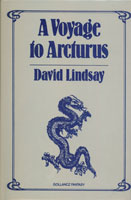
Thus, A Voyage to Arcturus was published in September 1920. 1,430 copies were printed;[32] 596 were sold[33] before it was remaindered. Reviews were mixed. Critics flailed for points of reference. The title sounded like Verne or Wells, but the content? “Baudelaire, or Poe in his most grisly vein”, suggested the Times Literary Supplement.[34] Lindsay had made the mistake of being innovative in both form and intent. Perhaps this was because he’d been living with the book for so long, perhaps it was simply that the reader had to feel, like the protagonist Maskull, that they’d been thrown in at the deep end, forcing them to work things out for themselves. Whichever it was, the publisher considered A Voyage to Arcturus a flop.
David had already started on his next novel.[35] When Methuen, then Hutchinson, rejected it,[36] it was suggested he try The Daily News, where Robert Lynd was now literary editor.[37] Again, there had to be a cut (20,000 words this time[38]), but it was accepted, and this led to Methuen reconsidering. Serialised in 1921,[39] The Haunted Woman was published in hardback in 1922. But again sales were slow.
By now the Lindsays had two daughters, Diana and Helen. David was enjoying the life of a writer in a large house with servants, trips to London and social gatherings.[40] As punctilious in literature as he’d been as a clerk, his work ethic kept him writing, but from now the process of both production and publication would become increasingly difficult.[41] Sphinx was rejected by three publishers, then an agent, before being taken on by the agent Ronald Massey.[42] The Adventures of M de Mailly was rejected by several publishers, one asking for alterations before deciding to pass on it.[43] Sphinx was accepted (by John Long) just in time to tie David’s hands with regards to a potentially career-making offer from publisher Jonathan Cape, who wanted to buy the rights to all his existing works and commission a collection of short stories.[44] de Mailly was finally published in 1926, and, in 1927, became the only book of Lindsay’s to be published in the United States during his lifetime, under the title A Blade for Sale. Neither The Ancient Tragedy, begun in 1923, nor The Violet Apple, written in 1924 and revised in 1925, ever found a publisher in his lifetime.
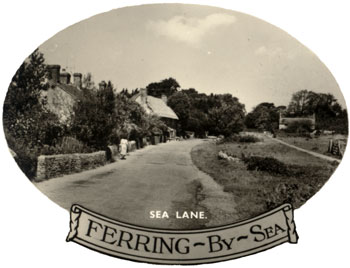
In just over five years Lindsay had written six novels. He would only complete one more (Devil’s Tor — itself a reworking of the rejected Ancient Tragedy[45]), before spending at least nine years on The Witch. In the face of his continuing lack of success, the family were forced to sell their house (which they’d named Lynscott[46] — it’s now the Porth Beach Hotel) and move to a smaller dwelling in nearby Trevelgue. In 1929, to further reduce expenses, they moved to a bungalow in Ferring,[47] near Worthing in West Sussex.
But it was not all bad news. Somehow, despite being remaindered, A Voyage to Arcturus had managed to attract attention. Lindsay began receiving letters from those few readers who recognised its genius; among them were two who would become important friends, the writers E H Visiak[48] and L H Myers.[49] Between them, Myers and Visiak plied the publisher Putnam’s with Lindsay’s existing works, before presenting them with the manuscript to Devil’s Tor.[50] Initially proclaiming it “a classic” with “a long life before it”, Putnam’s enthusiasm soon waned when it sold only 650 copies in the crucial first few months.[51] But the reviews, while not all positive, were at least a better mix. Some (by J B Priestley and Rebecca West, for instance[52]) made reference to A Voyage to Arcturus, implying that the book was not only not forgotten, but could be used as a point of reference, even if only among the very well read.
Lindsay began work on The Witch, intending to use it to bridge the “chasm of contradiction” he perceived between the philosophies of his first and latest novels.[53] But, for a man who had once specialised in financial problems, he was doing a very good job of ignoring his own. In the end, it was up to Jacqueline to take matters in hand. To provide the family with some much-needed income, she arranged a loan to buy a larger house in Hove[54] (on Pembroke Crescent), where they could take in boarders. Lindsay did not like the idea, but had no alternative.
Later Years
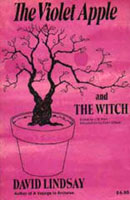
David Lindsay stopped work on The Witch in about 1939.[55] As to whether this book can be considered finished, it’s difficult to say. All but the final, twentieth, chapter was published by The Chicago Review Press in The Violet Apple and The Witch in 1975; the excluded chapter is as long as the previous nineteen put together, and reads like the proclamations of an Old Testament prophet.
E H Visiak, a close neighbour in Hove, describes Lindsay as both “one of the most equable and placable of men”[56] and “radically unhappy, dissatisfied, hungry for recognition”.[57] Lindsay’s biographer, Bernard Sellin, says he “achieved a kind of serenity of spirit”[58] in his last six years. But there were obviously difficulties. Financial worries had put a strain on his marriage. As the Second World War began, a bomb dropped near the Lindsay home, injuring David, who was taking a bath at the time.[59] Increasingly, he withdrew, finally retreating to his room at the top of the house and not emerging for an entire week, even to eat.[60] When he did come out, his wife was horrified at his appearance and insisted he go to hospital.[61] But it was too late. A dental abscess, left untreated for too long, had turned gangrenous. Blood poisoning set in, and David Lindsay died in hospital on the 16th July 1945.[62]
Literary Afterlife
The afterlife of A Voyage to Arcturus began almost immediately following its author’s death. Reacting to a “small but persistent demand”, Victor Gollancz reissued the novel in 1946 as part of their Connoisseur’s Library of Strange Fiction. The BBC Light Programme broadcast a discussion on David Lindsay’s works, though Jacqueline Lindsay thought it a “complete fiasco”.[63] In 1947, an anthology entitled Essays Presented to Charles Williams included “On Stories” by C S Lewis, in which he praised the “remarkable achievement” of “Mr David Lindsay’s A Voyage to Arcturus”. (The essay was originally a lecture, “The Kappa Element in Romance”, delivered at Merton College in 1940. Another contribution to the Essays was J R R Tolkien with a lecture of his own, “On Fairy Tales” — now a key document in any study of fantasy.)
In 1956, the BBC’s Third Programme produced a dramatisation of A Voyage to Arcturus. In 1963, Gollancz reissued the novel yet again. A Sunday Telegraph review of the reissue declared it “one of the strongest, and in some ways most powerful, books of our time.”[64] This year also saw the book’s first US publication.
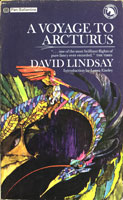
Arcturus was gaining readers. Two who would become key to the next, crucial stage of its acceptance as a classic were the publisher Betty Ballantine[65] and the writer Colin Wilson,[66] both of whom read the book (one in its US and the other in its UK editions) around this time. Wilson immediately recognised it as the work of “a forgotten genius” and “one of the greatest books of the century”.[67] He wrote to E H Visiak, beginning a correspondence that would lead to their collaboration, along with J B Pick, on the first book about Lindsay, The Strange Genius of David Lindsay, in 1970. (Pick had already written perhaps the first serious assessment of Lindsay’s body of work in an article for Studies in Scottish Literature, in January 1964.) Wilson used Arcturus as a course text when he taught at a women’s college in the US in 1967.[68] He had already written an essay on Lindsay (in Eagle & Earwig, 1965), and hearing that Ballantine, Tolkien’s US publisher, were looking to publish other works of fantasy to capitalise on the wildfire success of The Lord of the Rings, he wrote suggesting A Voyage to Arcturus.[69] This may have been how Ballantine heard about the book, though Gary Wolfe[70] suggests Betty Ballantine came across it as part of her own search for fantasy classics to republish. However it happened, Ballantine published A Voyage to Arcturus in paperback in November 1968, in what was to become known as the Ballantine Adult Fantasy series. This was, arguably, the most important event in Arcturus’s history since its initial publication. Gollancz had slogged on republishing the novel in hardback every decade or so, but it had to be in paperback (and, perhaps, in the US) to reach a really wide audience. At a time when fantasy-hungry fans would read anything sufficiently resembling The Lord of the Rings, A Voyage to Arcturus being issued by the same publisher was the best way to ensure it a wide readership. And, even if most people found it unreadable or incomprehensible compared to Tolkien’s work, it was sure to find at least some sympathetic readers. Being published as part of the Ballantine Adult Fantasy series was a key step in the book’s road to being accepted as a fantasy classic.
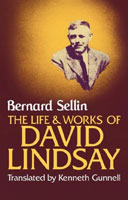
After 1968, A Voyage to Arcturus was to remain in print to the current day. Reissued in paperback and hardback regularly, it received its first translations in the 1970s, with editions in French, German, Spanish (in Spain and Argentina), Dutch, and, eventually, Bulgarian, Russian, Japanese, Catalan, Romanian, Turkish, Icelandic, Greek, Finnish, Serbian and Portuguese (see the Arcturus editions page for details). As part of a halo effect, not only did Lindsay’s other books get into print, but his previously-unpublished novels, The Violet Apple and The Witch, received their first editions. By the time of the publication of Bernard Sellin’s full-length study, The Life & Works of David Lindsay (1981), it was possible for the publisher to claim that “all of Lindsay’s books are currently available” — something that could not have been said even during Lindsay’s own lifetime. (Although the statement was wrong, missing out, as it did, The Adventures of M de Mailly, which was not to be reprinted till 2009.)
With its appearance as a downloadable text file on Project Gutenberg, A Voyage to Arcturus has become a standard choice for anyone with access to Print-on-Demand technology wishing to produce their own series of fantasy classics — the first decade of the 21st century saw at least 13 reissues of the novel, including a beautiful collector’s edition from Savoy. The Haunted Woman received similar treatment from Tartarus Press.
David Lindsay has certainly been justified in what he once said to the publisher Victor Gollancz: “Somewhere in the world, someone will be reading a book of mine every year.”[71]

Bibliography
Footnotes
- 1^ — details from David Lindsay’s birth certificate
- 2^ — stated on David’s birth certificate
- 3^ — Sellin, p.8
- 4^ — birth years from online genealogical records
- 5^ — Pick, p. 7
- 6^ — Sellin, p. 9
- 7^ — Sellin, p. 8-9
- 8^ — Kentish Mercury, May 4th 1888
- 9^ — J B Pick, The Great Shadow House, p. 74-5
- 10^ — Sellin, p. 9; Mrs Couchman’s full name from online census records
- 11^ — Sellin, p. 11, says a friend of David’s father, Pick, p. 7, says "on the recommendation of relations"
- 12^ — Sellin, p. 13
- 13^ — Sellin, p. 13
- 14^ — Sellin, p. 51
- 15^ — Pick, p. 9
- 16^ — Sellin, p. 246
- 17^ — Sellin, p. 197
- 18^ — Sellin, p. 17
- 19^ — details from Alexander Lindsay’s death certificate
- 20^ — Pick, p. 7
- 21^ — see my article on Alexander Lindsay in the Midlands.
- 22^ — Sellin, p. 17
- 23^ — details from marriage certificate
- 24^ — Sellin, p. 18
- 25^ — Sellin, p. 18
- 26^ — this, and all army career details, from David Lindsay’s war pension records
- 27^ — Sellin, p. 21
- 28^ — Wolfe, p. 9
- 29^ — Sellin, p. 22
- 30^ — dustjacket blurb for 1978 Gollancz edition
- 31^ — Sellin, p. 22
- 32^ — dustjacket blurb for 1978 Gollancz edition
- 33^ — Pick, p. 14
- 34^ — quoted in Pick, p. 3
- 35^ — Pick, p. 14
- 36^ — Pick, p. 14 & 15
- 37^ — Douglas A Anderson, Afterword to Tartarus Press edition of The Haunted Woman, p. 203
- 38^ — Pick, p. 15
- 39^ — Anderson, op. cit.
- 40^ — Pick, p. 10-11
- 41^ — Pick, p. 17
- 42^ — Pick, p. 18
- 43^ — Pick, p. 19
- 44^ — Sellin, p. 31
- 45^ — Pick, p. 19
- 46^ — online article from the Newquay Voice — see links page
- 47^ — Sellin, p. 37
- 48^ — Sellin, p. 39
- 49^ — Sellin, p. 39-40
- 50^ — Pick, p. 24
- 51^ — Pick, p. 24
- 52^ — both quoted in Pick, p. 24 & 26
- 53^ — Pick, p. 30
- 54^ — Sellin, p. 37
- 55^ — Pick, p. 30
- 56^ — E H Visiak, "Lindsay as I Knew Him", in The Strange Genius of David Lindsay, p. 97
- 57^ — Visiak, op. cit., p. 100
- 58^ — Sellin, p. 43
- 59^ — Sellin, p. 44
- 60^ — Pick, p. 31
- 61^ — J B Pick, The Great Shadow House, p. 76
- 62^ — Sellin, p. 44
- 63^ — Sellin, p. 56 & 237
- 64^ — Sellin, p. 57
- 65^ — Wolfe, p. 8
- 66^ — Colin Wilson, The Books in My Life, p. 155
- 67^ — Colin Wilson, "Lindsay as Novelist and Mystic" in The Strange Genius of David Lindsay, p. 35 & 36
- 68^ — Colin Wilson, introduction to The Violet Apple & The Witch, p. 3
- 69^ — Colin Wilson, introduction to The Violet Apple & The Witch, p. 3
- 70^ — Wolfe, p. 8
- 71^ — Wolfe, p. 9
